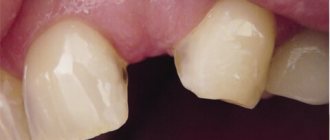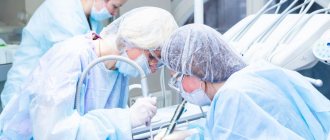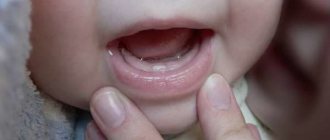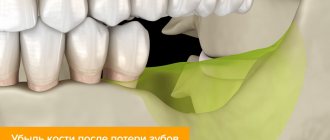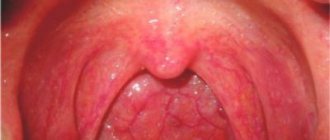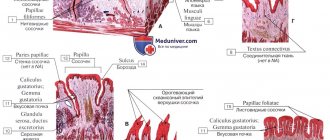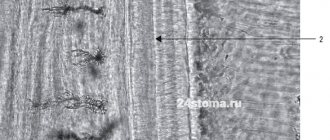Swallowing is a complex set of motor reactions that move food from the mouth through the esophagus to the stomach. The swallowing reflex is innate. It is important to note that during the correct act of swallowing, the tip of the tongue should normally rest against the anterior third of the hard palate.
A child is born with a well-developed swallowing mechanism, which in the first months is called infantile . Due to the contraction of the muscles of the lips, cheeks, and tongue during sucking, negative pressure is created in the baby’s mouth and milk enters the mouth, and the tongue, located between the toothless gums, directs the milk into the oropharynx. Before the first teeth erupt, this infantile type of swallowing , in which the tongue rests on the lips, is a physiological norm . But as baby teeth erupt, sucking is replaced by chewing, and the child’s type of swallowing changes to somatic . During somatic swallowing, the tongue is located in the anterior third of the hard palate, while the back of the tongue pushes food into the larynx.
If a child constantly consumes liquid or semi-liquid food, despite the presence of teeth, then a full act of chewing is not formed, and the transition from the infantile type of swallowing to the somatic one does not occur. At the moment of swallowing, a child with an infantile type of swallowing places his tongue between the upper and lower rows of teeth, which contributes to the formation of an open bite. In this case, the perioral muscles are involved in the act of swallowing, i.e. the lower part of the orbicularis oris muscle, the mentalis muscle and the neck muscles noticeably tense, which is easy to detect by asking the child to swallow saliva.
An incorrect type of swallowing can also result from:
- Using a long pacifier that occupies the entire mouth of the infant and touches the soft palate, which interferes with the proper function of the tongue, soft palate and pharynx.
— Disturbances also occur when there is a large hole in the nipple, through which milk and milk formulas enter the oral cavity in large quantities, the child choke on the incoming food and can swallow it only after the nipple is removed from the mouth and the food flows out through the corners of the mouth. In this case, the forward position of the tongue, which regulates the flow of milk, can become fixed and cause improper swallowing.
— Chronic tonsillitis and adenoid growths also contribute to the tongue moving forward.
- If a child constantly consumes liquid or semi-liquid food, despite the presence of teeth, then a full-fledged act of chewing is not formed, and the transition from the infantile type of swallowing to the somatic one does not occur.
With the infantile type of swallowing, the child’s tongue gets used to only the simplest movements, so the lingual muscle develops poorly (the tongue is not sufficiently developed and mobile).
The influence of swallowing function on the formation of the dental system
Swallowing is a complex set of motor reactions that move food from the mouth through the esophagus to the stomach. The swallowing reflex is innate. Normally, 22 muscles of the maxillofacial region, sublingual region and pharynx take part in the act of swallowing. A child is born with a well-developed swallowing mechanism, which in the first months is called infantile. Due to the contraction of the muscles of the lips, cheeks, and tongue, when sucking, negative pressure is created in the baby’s mouth and milk enters the mouth, and the tongue, located between the toothless gingival ridges, directs the milk into the oropharynx. Before the first teeth erupt, this infantile type of swallowing, in which the tongue rests on the lips, is the physiological norm. But as baby teeth erupt, sucking is replaced by chewing, and the child’s type of swallowing changes to somatic: during somatic swallowing, the tongue is located in the anterior third of the hard palate, while the back of the tongue pushes food into the larynx.
If we analyze in more detail the biomechanics of this process, the act of swallowing as a whole consists of two phases: first, with movements of the tongue, food is delivered to the cutting surface of the teeth, where it is mixed with saliva, then, with contraction of the muscles of the floor of the mouth (hyoid bone, larynx and back of the tongue), it is pressed , rising from front to back to the hard and soft palate, pushing it towards the pharynx. The first phase of swallowing is voluntary and is associated with the action of the tongue and the muscles of the floor of the mouth. Once food passes the throat, swallowing becomes involuntary. The first phase of swallowing takes 0.7-1 s, and the second (passage of food through the esophagus) - from 4-6 to 8 s.
It is important to note that during the correct act of swallowing, the tip of the tongue should normally rest against the anterior third of the hard palate. If a child constantly consumes liquid or semi-liquid food, despite the presence of teeth, then a full act of chewing is not formed, and the transition from the infantile type of swallowing to the somatic one does not occur. At the moment of swallowing, a child with an infantile type of swallowing places his tongue between the upper and lower rows of teeth, which contributes to the formation of an open bite. In this case, the perioral muscles are involved in the act of swallowing, i.e. the lower part of the orbicularis oris muscle, the mentalis muscle and the neck muscles noticeably tense, which is easy to detect by asking the child to swallow saliva.
With the infantile type of swallowing, the child’s tongue gets used to only the simplest movements, so the lingual muscle develops poorly. As a result, macroglossia is often mistakenly diagnosed, while the child’s tongue is simply not sufficiently developed and mobile. Improper swallowing is very often combined with oral or mixed breathing. That is why the problem of correcting myofunctional disorders in such children is especially acute. If swallowing function is impaired, a specific treatment plan is outlined. First you need to teach your child to swallow correctly.
Exercises to normalize the function of swallowing Sitting in front of a mirror, keep your head straight, shoulders slightly back and slightly lowered, chest out, stomach tucked, knees bent, legs and heels together. The exercises are performed at a slow pace on a count of 1-2-3-4 and repeated 10 to 15 times daily. Exercise 1. Half-open your mouth, lick your upper and lower lips, running your tongue from one corner of your mouth to the other. Try to reach the nasal septum and chin with your tongue. Run the tip of your tongue along the lingual and then along the vestibular surface of the teeth, as if counting them, click your tongue, to do this, suck your tongue with your lips closed to the hard palate, and, slowly opening your mouth, rest the tip of your tongue on one or the other cheek. Exercise 2. Place the rubber ring from the pipette on the tip of the tongue, lift the tongue up and press it to the anterior part of the hard palate in the area of the palatine folds. Clench your teeth without closing your lips, swallow saliva without changing the position of the tip of your tongue and the rubber ring. Repeat the exercise 5-10 times 3 times a day. Perform the same exercise not with a ring, but with water, which must be swallowed. Exercise 3. Raise the tongue up and place it at the anterior part of the hard palate, then move it along the arch of the hard palate in the anterior part and as far back as possible to the soft palate. Exercise 4. Click your tongue, imitating the sound of a horse's hooves. Perform 50-60 times. Exercise 5. Clench your teeth, close your lips, rest the tip of your tongue on the hard palate - in the projection of the roots of the central incisors, swallow saliva. A trainer is very effective for correcting infantile swallowing. With each swallowing movement, the tongue of the apparatus reflexively reminds the child of the correct position of the tip of the tongue, which is reinforced during night wear and contributes to the restructuring of the infantile type of swallowing into the somatic one.
The use of myofunctional preventive trainers for the correction of swallowing and breathing dysfunctions in children in mixed dentition. Long-term disruption of nasal breathing in childhood not only negatively affects the development of the chest skeleton, but also leads to deformation of the facial skeleton: the upper jaw develops incorrectly, its lateral parts come closer together, the hard palate becomes narrow and high. As a result, the upper dentition narrows, causing crowding of the upper and then lower jaw teeth. In addition, in children with mouth breathing, the viscosity of saliva increases, oral hygiene deteriorates, which leads to the development of acute caries and periodontal inflammation. This problem, caused by the consequences of mouth breathing in children, is very common in the practice of pediatric dentists. Normalizing nasal breathing is only possible through comprehensive treatment from a pediatrician, otolaryngologist and orthodontist or pediatric dentist.
A few words about the physiology of the process. The air inhaled through the nose, passing through the nasal passages, undergoes a number of significant changes. It is moistened, warmed, cleaned, and disinfected. However, there are a number of conditions when breathing through the nose is difficult. This happens if catarrhal or hypertrophic processes occur in the nasal cavity. It is noted that the number of microorganisms penetrating into the lower respiratory tract with proper nasal breathing is reduced by 10 times compared to their number with oral breathing. Therefore, impaired nasal breathing contributes to sore throat, acute respiratory diseases, bronchitis, and pneumonia. Free nasal breathing is necessary for normal gas exchange in the blood, since when breathing through the mouth, the amount of oxygen entering the human body is only 78% of its normal volume. A prolonged lack of oxygen in the body can contribute to the development of anemia. The blood and lymphatic vessels of the nose are closely connected with the vessels of the brain, and therefore, with prolonged difficulty breathing, both in the nasal cavity and in the brain tissue, blood circulation is disrupted.
Normalizing nasal breathing most often prevents the growth of adenoid tissue, which is why many children undergo surgery. But does adenectomy lead to complete restoration of nasal breathing? We decided to answer this question by treating orthodontic disorders accompanied by oral breathing using silicone trainers - so-called trainers, intended for the treatment of children of both preschool and primary school age suffering from malocclusions, bad habits, and impaired nasal breathing.
We examined 222 children aged 6-8 years. Control examinations of children were carried out once every 3 months. It was recommended to wear the preorthodontic trainer 1 hour a day for active myotraining and put it on at night. Children with nasal breathing dysfunction were additionally offered breathing exercises. Parents were given detailed instructions on the use of this technique. The treatment plan using a trainer was determined for each child individually, depending on his psycho-emotional status. In addition, all children were trained in rational oral hygiene, the status of which was recorded during each examination using the OHI-S index. The acid resistance of enamel was determined by the TER test on a ten-point scale (from 10 to 100%). All research data are statistically substantiated and reliable.
During the initial examination, 87 children out of 222 examined showed mouth breathing, 81 had infantile swallowing, and 54 children had concomitant pathology. In almost all children, the hygiene index ONI-S at the initial examination was 2.4 (low level), and the test for enamel resistance was close to 72%, which indicates a low level of enamel resistance. In 43 patients with infantile swallowing, correction was performed using a pre-orthodontic trainer. After 6 months after the start of treatment, function returned to normal in 51% of children. After 12 months Correct swallowing was achieved in 30% of children who used a myofunctional trainer for correction.
For comparison, the remaining 38 patients observed with swallowing dysfunction were prescribed a course of myogymnastics. What is significant is that these children did not experience significant changes during the year.
Of the 87 patients with habitual mouth breathing, 42 used a preorthodontic trainer to correct dysfunction, and after 6 months. approximately half of these children learned to breathe through their nose. A year later, the function returned to normal in 80% of children who used a trainer for correction, while in 45 patients with the same pathology who did not wear a trainer but performed breathing exercises for the same time, there was no practical improvement.
In children with concomitant pathology (simultaneous dysfunction of swallowing and breathing), who wore the trainer for a year, objective signs significantly improved, but complete elimination of dysfunction occurred only in 30% of patients. In such children, it is necessary to first normalize nasal breathing and only then devote time to restoring swallowing function. The period of adaptation to the trainer for this group lasted almost 2 times longer. Children with concomitant pathology who did not use the device did not experience any improvement over the course of a year. All children with concomitant pathology were recommended breathing exercises and given an additional course of myogymnastics.
Based on the results of the study, the following conclusions can be drawn. 1. The use of a preorthodontic trainer has high clinical effectiveness and contributes to the successful correction of breathing and swallowing dysfunctions in children in mixed dentition. 2. Correction of myofunctional influences in the pre-orthodontic period can be carried out by pediatric specialists (dentists and pediatricians, speech therapists) in combination with breathing exercises and myogymnastics.
Compiled by a pediatric dentist, Ph.D. honey. Sciences E.A. Satygo (St. Petersburg).
Classification and symptoms
Pathology varies depending on the location of the lesions, causes and severity.
| By place of education | |
| Oropharyngeal (oropharyngeal) | The location of the lesion is the oropharynx area . The food lump moves from the pharynx into the esophagus with difficulty. During swallowing, the child begins to choke, causing food to enter the trachea or nasal cavity. Oropharyngeal dysphagia occurs as a result of disruption of the neuromuscular connection. Characterized by a severe cough and increased salivation. In order for food to pass through the esophagus, the baby has to make efforts. |
| Esophageal | The lesion occurs in the lower region of the esophagus, and difficulty swallowing appears in the cervical region. The symptoms of esophageal dysphagia are similar to oropharyngeal dysphagia, so a doctor can make an accurate diagnosis during an examination. Characterized by frequent belching with a sour taste, severe heartburn, and pain in the chest cavity. |
| Cricopharyngeal | A disorder in the contraction of certain fibers, which causes relaxation of the cricopharyngeal muscle. This contributes to bulging of the walls of the esophagus and the formation of lung pathologies. |
| By appearance | |
| Paradoxical | The child has difficulty swallowing, but solid food passes better than liquid food. Often occurs against the background of diseases of the esophagus. If tumors are present, the baby may begin to refuse solid foods, then semi-liquid foods and drinks. There are cases when dysphagia disappears. But this is an imaginary remission and the disorder will soon make itself felt. |
| Neurogenic | The nervous system is affected. The formation of a food bolus in the oral cavity is difficult or the bolus simply does not pass through the esophagus. Neurogenic dysphagia can be caused by severe traumatic brain injury or stroke. |
| Sideropenic | Dystrophic changes in the mucous membranes of the esophagus. This may be indicated by a deficiency of iron and nutrients in the body, which leads to pathological changes in the swallowing muscles. It can be either a genetic or acquired disorder. |
| Psychogenic | Occurs due to frequent stress and nervous tension. While eating, the baby feels a “lump” in the throat and pain in the chest area. Severe heartburn may occur. |
| Due to the occurrence | |
| Functional (nervous) | A disorder of the esophagus resulting from a disorder of the nervous system. The child has difficulty swallowing food, may refuse to eat, gag reflexes, and breathing and sleep disturbances occur. |
| Organic | As a result of diseases that led to disorders of the oropharynx and esophagus. |
Infantile breathing
Swallowing is a certain set of motor reactions that ensure the normal passage of food from the mouth to the stomach through the esophagus.
During the correct act of swallowing, the tip of the tongue rests on the anterior third of the hard palate. Many people believe that swallowing is a reflex reaction of the body, i.e. to the same as salivation, breathing, reflexive withdrawal of the hand in case of touching something hot, etc. In other words, they believe that swallowing is wrong - it is impossible. But, unfortunately, this phenomenon is not so rare and is called infantile swallowing.
Why does an orthodontist often work together with an ENT doctor?
Breathing problems rank third among the causes of improper development of the dental system in children, after genetic and hereditary ones.
It is important to understand why a child’s bite is deteriorating and not to miss the moment. A good orthodontist will check whether the child is breathing correctly, and if mouth breathing is suspected, he will immediately involve an ENT specialist.
As we wrote above, correcting a malocclusion is possible only after the child learns to breathe through his nose again. To do this, you need to cure diseases that interfere with nasal breathing. Most often you have to deal with inflammation of the nasal and nasopharyngeal mucosa, sinusitis and proliferation of adenoid tissue. This is what an ENT doctor does.
What is dysphagia
Dysphagia is a violation of the complex reflex swallowing act. The ICD-10 code is R13. This is a secondary pathological process that develops against the background of other diseases. This condition is manifested by the inability or difficulty of swallowing, pain when swallowing, liquid or food getting into the trachea, larynx and nose.
Dysphagia must be distinguished from odynophagia, which is defined as a sensation of pain when food passes through the esophagus. This condition must also be distinguished from the sensation of a lump in the throat, when a person feels that something is stuck in the back of the throat. In this case, dysphagia is a symptom that appears only when attempting to swallow.
Why does a child need an orthodontist after early milk tooth extraction?
Has your child had a baby tooth removed, but the permanent one is still a year or more away? Then there is a danger that the baby’s bite will deteriorate. After removal, neighboring teeth will really want to move and take up the vacated space. If you do not install a special prosthesis or a special orthodontic spacer, then the permanent tooth will have nowhere to go, and it will erupt where necessary, and not where it should. In this case, it is impossible to do without the intervention of an orthodontist.
Therefore, dear fathers and mothers, let’s agree that if a child under 5 years old has gaps in his teeth, then at a minimum he definitely needs a consultation with an orthodontist!
Main reasons
Problems with the passage of food through the pharynx and proximal esophagus are caused by the following reasons:
- Mechanical obstruction. It can be caused by inflammatory processes, enlarged lymph nodes, thyroid hyperplasia, muscle fibrosis, etc. Narrowing of the upper digestive tract can also be a consequence of malignant tumors of the pharynx, oral cavity and larynx.
- Quincke's edema and foreign body obstruction are often a consequence of acute esophageal dysphagia.
- Narrowing of the lumen of the esophagus. This happens with stomach cancer, malignant tumors in the esophagus, and eozonophilic pharyngitis. Signs of pathology are observed when the lumen of the esophagus narrows to less than 12 mm.
- External compression of the esophagus. These can be chest tumors, enlarged midwall lymph nodes, as well as various infectious diseases - histoplasma, tuberculosis, etc.
- Impaired coordinated contraction of the esophageal muscles. Occurs in diabetes mellitus, scleroderma, achalasia. The contraction of the esophageal muscles, which prevents swallowing, is affected by the intake of estrogens, nitrates, and calcium channel blockers.
Common symptoms of dysphagia
At the initial stage of the pathology, patients complain of problems when swallowing solid food, which are accompanied by discomfort in the larynx. The characteristic symptoms of this disorder are as follows:
- excessive salivation (or inability to swallow saliva);
- hoarseness or hoarseness of voice;
- dry cough;
- feeling of lack of air and distension behind the sternum;
- sore throat.
As the pathology progresses, a person has problems swallowing liquids. There is anxiety about eating, food getting into the respiratory organs. If no correction methods are taken, the person’s general condition of the body worsens, and body weight also decreases significantly.
Diagnostics
After the patient is admitted to the department, the quality of swallowing is assessed using a special dysphagia rating scale.
According to the severity of this pathology, 4 degrees are distinguished. With the first, there are problems with swallowing solid foods, with the second, a person can only swallow liquid food. In the third degree, there is difficulty swallowing both solid and liquid food, and in the fourth degree, a person cannot even swallow his own saliva.
When collecting anamnesis, it is necessary to clarify:
- What kind of food intake causes problems with swallowing (problems with swallowing solid foods are more typical for the esophageal form of the pathology, liquid - for the oropharyngeal).
- The time interval between the act of swallowing and the feeling of a “coma”. The feeling of a “coma” in most cases excludes a mechanical cause for this condition.
- The nature of the increase in symptoms. If the nature is progressive and short (less than three months), then a malignant tumor can be suspected.
- The presence of heartburn, regurgitation, coughing while drinking and eating.
Treatment of dysphagia
How dysphagia will be corrected depends on the type of disorder:
- Drug treatment. Medicines are prescribed that reduce the acidity of gastric juice, and antibiotics may also be prescribed. Use of all medications only under the supervision of a physician.
- Surgical intervention. Surgery is prescribed if there is no effect from medications and other treatment methods. Most often, surgery is necessary in the case of burns, cancerous tumors and severe inflammatory lesions.
- Diet therapy. Fatty, fried, smoked, spicy and spicy foods, including fast food, are excluded. Food should be chewed thoroughly to avoid large chunks of food being swallowed. Eat small, frequent meals.
- Speech therapist classes for dysphagia. The recovery process of speech disorders is carried out in conjunction with the treatment of the underlying disease that caused the disorder.
Symptoms of infantile swallowing
With infantile swallowing, the following signs are present:
- The lips are closed or open, but when swallowing food they are compressed even more tightly due to contraction of the muscles of the mouth.
- The tongue rests on the lower teeth, or is located between the upper and lower rows of teeth.
- The muscles of the neck and the mental muscle are also involved in the implementation of infantile swallowing.
With this condition, the lower part of the face turns out to be very tense, which can be seen in pinpoint pits in the corners of the mouth and on the skin of the chin. Due to the fact that the neck muscles are involved in the swallowing process, it involuntarily stretches.
Diagnostics
In most cases, infantile swallowing leads to malocclusion. Problems with swallowing are most often identified during additional examination:
- Examination by a dentist. The specialist detects defects in the dentition and mouth breathing. The easiest way to detect it is to swallow water in small portions.
- X-ray of the pharynx and esophagus, which helps to trace the movements of the tongue, as well as estimate the time of swallowing.
- Examination of the nasopharynx. A specialist performs pharyngoscopy and nasal endoscopy.
- Speech therapy diagnostics. A speech pathologist evaluates the relationship between infantile swallowing and incorrect pronunciation of sounds. During the examination of oral speech, lateral, interdental pronunciation and other defects are revealed.
Bite problems begin in early childhood
The health of first the child and then the adult depends on the attention and care of parents.
But often parents do not pay attention to how the first teeth grow; anyway, they will fall out and there will be new ones. They believe that it is normal not to treat even caries and pulpitis, let alone crooked teeth, their uneven location in the jaw, a frenulum that is too large or, conversely, too small. It seems to them that all children suck their thumbs or constantly breathe through their mouths. Parents do not see such “little things” as a problem. They think that it is too early, and after replacing the teeth with permanent ones, everything will return to normal on its own. So why waste money and torture a child? Unfortunately, with the formation of a permanent bite, all milk problems do not go away, but, on the contrary, begin to actively worsen. A person enters adult life with an ugly smile, an incorrect bite and, often, with deformation of facial proportions. And this is only the visible part of the troubles; problems with bite affect the entire human body. Read more about this in our article on adult orthodontics.
On this page you will learn everything parents need to know so that their child has a healthy bite and straight teeth.

